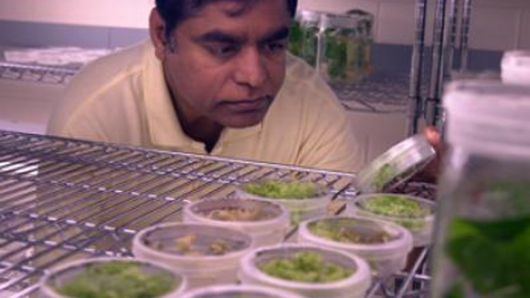Cleaner, cheaper fuel from orange peels and newspaper
By Darren Quick
21:24 February 18, 2010 PST

While it may not quite be the Mr. Fusion energy reactor Doc Brown
uses to convert household scraps into power for his time-traveling
DeLorean, scientists have found a way to turn discarded fruit peels,
newspapers and other waste products into cheap fuel to power the world’s
vehicles. Its developer says the new approach is greener and less
expensive than the current methods available to run vehicles on cleaner
fuel and is part of his goal to relegate gasoline to a secondary fuel.
University of Central Florida professor Henry Daniell developed a
technique with the U.S. Department of Agriculture that uses
plant-derived enzyme cocktails to break down orange peels and other
waste materials into sugar, which is then fermented into ethanol. The
breakthrough can also be applied to several non-food products including
sugarcane, switchgrass and straw.
Currently cornstarch is fermented and converted into ethanol, but
ethanol derived from corn produces more greenhouse gas emissions than
gasoline does. Daniell says ethanol created using his approach produces
much lower greenhouse gas emissions than gasoline or electricity.
There’s also an abundance of waste products that could be used without
reducing the world’s food supply or driving up food prices – a common
concern for deriving fuel from biomass. In Florida alone, discarded
orange peels could create about 200 million gallons of ethanol each
year, Daniell said. According to Daniell no company in the world can
produce cellulosic ethanol – ethanol that comes from wood or the
non-edible parts of plants.
Depending on the waste product used, a specific combination or
"cocktail" of more than 10 enzymes is needed to change the biomass into
sugar and eventually ethanol. Orange peels need more of the pectinase
enzyme, while wood waste requires more of the xylanase enzyme. All of
the enzymes Daniell's team uses are found in nature, created by a range
of microbial species, including bacteria and fungi.
Daniell's team cloned genes from wood-rotting fungi or bacteria and
produced enzymes in tobacco plants. Tobacco was chosen as an ideal
system for enzyme production because it is not a food crop and it
produces large amounts of energy per acre. Producing these enzymes in
tobacco instead of manufacturing synthetic versions could reduce the
cost of production by a thousand times, which should significantly
reduce the cost of making ethanol, Daniell said.
Copyright © gizmag 2003 - 2010 To subscribe or visit go to: http://www.gizmag.com